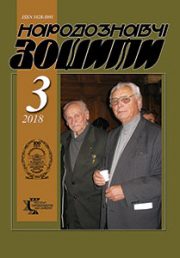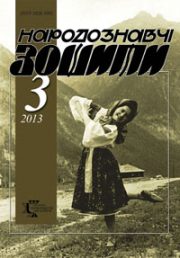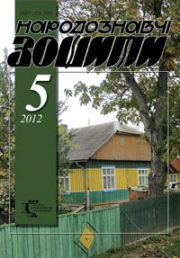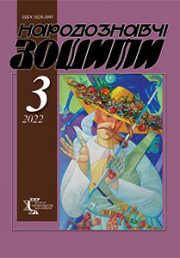The Ethnology Notebooks. 2023. № 4 (172), 858—868
UDK 069.7(477.83-25)”191/193″:[39(=161.2):316.422]
DOI https://doi.org/10.15407/nz2023.04.858
MUSEUM COLLECTIONS OF THE UKRAINIAN COMMUNITY OF LVIV IN THE PERIOD BETWEEN THE TWO WORLD WARS
HORBAN Iryna
- ORCID ID: https://orcid.org/0000-0002-2626-9521
- Candidate of Philological Sciences (Ph. D.), Associate Professor,
- Senior Researcher at the Museum of Ethnography
- and Art Crafts of the Ethnology Institute
- of the National Academy of Sciences of Ukraine,
- 15, Svobody Avenue, 79000, Lviv, Ukraine,
- Contacts: e-mail: iryna_lviv@ua.fm
Abstract. The establishment of the Ukrainian movement in Galicia and the desire to declare their national distinctiveness led to an increase in public interest in their own history and culture in the second half of the 19th century. In Lviv, among the public-cultural institutions of Galician Ukrainians, the «People’s House», the «Prosvita» society, the Stavropegian Institute, and the Shevchenko Scientific Society, museum collections of historical monuments — material carriers of Ukrainian cultural identity — were established. All of these mentioned museums played an important role in the development of Ukrainian museology in the Galician territories. However, they functioned only as separate branches within the structure of the organizations or societies where they were created and mostly lacked proper premises, professional personnel, defined activity programs, and necessary funding. All of the mentioned criteria were met by the museum founded by Metropolitan Andrey Sheptytsky, which operated from 1911 under the name «National Museum in Lviv». The last among the Ukrainian museums in Lviv, the Museum of the Greek Catholic Theological Academy, began its work in 1931.
The purpose of the proposed research is to present the history of museum collections of the Ukrainian community in Lviv and the peculiarities of their functioning during the interwar twenty years. For the first time the following state and activities of the two largest Ukrainian museum institutions in the city — the National Museum and the Museum of the Shevchenko Scientific Society during the 1920—1930s were considered in a comparative aspect; the process of accumulation of monuments and formation of collections were characterized, as well as research work, and also measures to popularise Ukrainian cultural heritage; the importance of these institutions in the cultural and artistic life of the Ukrainian community of the city was determined.
The relevance of the research is determined by the lack of comprehensive studies dedicated to this issue. The research is based on published works, archival documents and photographic materials from the collections of museums and archival institutions in Ukraine and Poland, in particular, unknown to Ukrainian researchers materials stored in the Archive of Modern Records in Warsaw and the Archives of the National Museum in Krakow, which are first introduced into scientific circulation.
Keywords: Museum of the Shevchenko Scientific Society, National Museum in Lviv, Museum of the People’s House, Museum of the Stavropegian Institute, museums of the Ukrainian community in Lviv.
Received 31.07.2023
REFERENCES
- Skrypnyk, H.A. (1989). Ethnographic museums of Ukraine. Formation and development. Kyiv: Naukova dumka [in Ukrainian].
- A—150/4. Request of I. Svientsitsky to appoint a representative to receive exhibits of the Museum of the «Prosvita» Society, which are to be deposited in the NM. Signed by the director of the Society’s office. Lviv, May 19, 1913. Archives of the National Museum in Lviv [in Ukrainian].
- Shpyrka, H. (2007). The Museum of the «People’s House» in Lviv (second half of the XIX — early XX centuries). Collection of scientific works of H.S. Skovoroda Kharkiv National Pedagogical University. Series «History and Geography» (Pp. 240—248). Kharkiv: Maidan [in Ukrainian].
- Lylo‑Otkovych, Z. (2000). Archaeological and bibliographic exhibition in Lviv in 1888—1889. Visnyk of the Lviv University. Historical series (Issue 35—36, pp. 605—613). Lviv [in Ukrainian].
- Szaraniewicz, I. (1892). Museum of the Stauropegian Institute in Lviv. Conservator’s portfolio. Yearbook of the Circle of C.K. Conservators of Ancient Monuments of Eastern Galicia (Pp. 53—60). Lviv [in Polish].
- Kyrychuk, O. (1999). Stavropigian Institution in the Preservation and Study of Material Culture Monuments. The Ethnology notebooks, 6 (30), 880—884 [in Ukrainian].
- Kushnir, V. (2005). Establishment of the Lviv Museum of the Shevchenko Scientific Society: Socio‑Political and Cultural Context. Historical monuments of Galicia: Materials of the third scientific local history conference (19.11.2004) (Pp. 19—25). Lviv: Ivan Franko National University Publishing Center [in Ukrainian].
- (1913 ?). Temporary catalog of the Ukrainian National Museum at the Shevchenko Scientific Society in Lviv. Departments of archeology and ethnography. Lviv: Printing House of the Shevchenko Scientific Society [in Ukrainian].
- Kushnir, V. (2004). Lviv Museum of the Shevchenko Scientific Society in 1895—1914. Museum business and museum policy in Ukraine in the twentieth century. Works of the Museum of Ukrainian Folk Decorative Art. Scientific collection based on the materials of the scientific and practical conference dedicated to the 135th anniversary of M. Bilyashivsky and the 125th anniversary of D. Shcherbakivsky (Issue 45, pp. 107—110). Kyiv: Zlatohraf [in Ukrainian].
- Kushnir, V. (2012). Museum of the Shevchenko Scientific Society in Lviv: from its foundation to the creation of the first public exhibition. The Ethnology notebooks, 5 (107), 824—832 [in Ukrainian].
- Hontar, T. (1992). Ethnographic collections the Museum of the Shevchenko Scientific Society. Memoirs of the T. Shevchenko Scientific Society. Works of the Section of Ethnography and Folklore (Vol. 223 (ССХХІІІ), pp. 417—427). Lviv [in Ukrainian].
- Pavlychko, Ya. (2006). Ilarion Svientsitsky is a museologist and book critic. Chronicle of the Andrey Sheptytsky National Museum in Lviv, 4 (9), 19—23 [in Ukrainian].
- Khodak, I. (2004). To the history of the creation of national museums in Kyiv and Lviv. Museum business and museum policy in Ukraine in the twentieth century. Works of the Museum of Ukrainian Folk Decorative Art. Scientific collection based on the materials of the scientific and practical conference dedicated to the 135th anniversary of M. Bilyashivsky and the 125th anniversary of D. Shcherbakivsky (Issue 45, pp. 88—98). Kyiv: Zlatohraf [in Ukrainian].
- Svientsitsky, I. (1913). Illustrated guide to the National Museum in Lviv. Zhovkva: Printing House of Basilian Fathers [in Ukrainian].
- Batih, M. (2000). White pages in the history of the National Museum in Lviv. Chronicle of the National Museum in Lviv, 1 (6), 5—29 [in Ukrainian].
- Sydor, O. (2004). National Museum in Lviv in the history of museums in Galicia in the late nineteenth and early twentieth centuries. Chronicle of the National Museum in Lviv, 3 (8), 5—33 [in Ukrainian].
- Tretiak, N.H. (1929). In defense of the Galician‑Russian museums (To the case of the Stavropigii Institute and the People’s House). Lviv [in Russian].
- Questionnaire for Museums and museum collections. Reporting year 1932. Museum of the Ruthenian National Institute «People’s House». The Archive of Modern Records in Warsaw. F. 14. Od. save 7003. Arc. 262 [in Polish].
- Orlevych, I. (2013). The Return of the Stavropegian Museum to Lviv in the Context of the Confrontation between Russophiles and Ukrainophiles. Ukraine: cultural heritage, national consciousness, statehood (Issue 23, pp. 389—401) [in Ukrainian].
- Questionnaire for Museums and museum collections. Reporting year 1932. Museum of the Stavropegian Institute. The Archive of Modern Records in Warsaw. F. 14. Od. save 7003. Arc. 176 [in Polish].
- А—543/9. Report on the work of the Second Congress of Ukrainian museologists on June 3—4, 1933 in Sambir. Archives of the National Museum in Lviv [in Ukrainian].
- Khorkava, I. (2018). The Role of the Faculty and Students of the Greek Catholic Theological Academy in Lviv in the Organization of its Museum. Eminak, 1 (21) (Vol. 3, pp. 123—127). Retrieved from: http://nbuv.gov.ua/UJRN/eminak_2018_1%283%29__20 (last accessed: 27/12/2019) [in Ukrainian].
- Siletska, L. (1997). To the history of the exposition of the Museum of the Scientific Society named after T. Shevchenko (1895—1939). The Ethnology notebooks, 3 (15), 148—151 [in Ukrainian].
- Burdulaniuk, V.M. (2009). Museums of the Shevchenko Scientific Society. Newsletter of Precarpathian University. History (Issue XV, pp. 3—10). Ivano‑Frankivsk [in Ukrainian].
- Kushnir, V. (2006). The development and activities of the Lviv Museum of the Shevchenko Scientific Society in 1919—1940. Museums of folk art and national culture. Works of the Museum of Ukrainian Folk Decorative Art. Scientific collection based on the materials of the scientific and practical conference «The Role of Museums and Collections of Folk and Decorative Art in the Preservation and Development of National Culture» (Issue 49, pp. 90—95). Kyiv: Zlatohraf [in Ukrainian].
- Kushnir, V. (2004). The Collection of the Lviv Museum of the Shevchenko Scientific Society in 1920—1939: Structure and Development. Volyn Museum: history and modernity. Scientific collection. Materials of the III All‑Ukrainian Scientific and Practical Conference: Lutsk; Kolodyazhne, May 18—19, 2004 (Issue 3, pp. 198—201). Lutsk [in Ukrainian].
- Hakh, I. (2014). The great gift of the Metropolitan (V). Retrieved from: http://zbruc.eu/node/17872 (last accessed:: 11/05/2015) [in Ukrainian].
- Yurkevych, O.T., & Kyrchiv, R.F. (Ed.). (1992). Materials for Ukrainian‑Ruthenian ethnology (Publication of the Ethnographic Commission of the Shevchenko Scientific Society in Lviv 1899—1929): Syst. annotation show content. Academy of Sciences of Ukraine; Vasyl Stefanyk National Scientific Library. Lviv [in Ukrainian].
- Aleksandrovych-Pavlychko, Ya. (Ed.). (1995). Catalog of scientific works of employees of the National Museum in Lviv (1905—1995). Lviv [in Ukrainian].
- Svientsitsky, I. (Ed.). (2013). Twenty‑fifth anniversary of the National Museum in Lviv. Scientific Foundation of Galician Metropolitan Andrei Sheptytskyi 1905—1929. Republished by the National Museum in Lviv named after Andrei Sheptytskyi since 1930. Lviv [in Ukrainian].
- Kushnir, V. (2003). On Western Ukrainian museum congresses of 1930s. The Ethnology notebooks, 5—6 (53—54), 827—834 [in Ukrainian].
- Boiko, V., & Koval, L. (1996). Formation and main milestones of the Museum of Historical and Military Monuments. Scientific notes. Lviv Historical Museum (Issue V, pp. 33—46). Lviv [in Ukrainian].
- Questionnaire for Museums and museum collections. Reporting year 1932. Ukrainian National Museum in Lviv. The Archive of Modern Records in Warsaw. F. 14. Od. save 7003. Arc. 195 [in Polish].
- Questionnaire for Museums and museum collections. Reporting year 1932. Museum of the Shevchenko Scientific Society in Lviv. The Archive of Modern Records in Warsaw. F. 14. Od. save 7003. Arc. 38 [in Polish].
- Kushnir, V. (2021). Museum of the Shevchenko Scientific Society (1892—1940). Lviv: Institute of Ethnology of the National Academy of Sciences of Ukraine [in Ukrainian].
- Hakh, I. (2014). The great gift of the Metropolitan (III). Pages of the history of the National Museum in Lviv. Continuation. Retrieved from: http://zbruc.eu/node/13966 (last accessed: 11/05/2015) [in Ukrainian].
- Rizun, I. (2010). Coverage of the activities of the National Museum in Lviv in the newspaper «Meta» (1931—1939). Chronicle of the National Museum in Lviv, 7 (12), 112—131 [in Ukrainian].
- Hakh, I. (2014). The great gift of the Metropolitan (IV). Anniversary celebrations in 1935. Retrieved from: http://zbruc.eu/node/16614 (last accessed: 11/05/2015) [in Ukrainian].
- Nadopta, A. (2012). Cultural, educational and scientific activities of the Museum of the Shevchenko Scientific Society at the late XIX — 30s of the XX century. Museums of Lviv: events, collections, people. Materials of the scientific and practical conference. Lviv, October 27—28, 2011. Lviv Historical Museum (Pp. 19—30). Lviv: Romus‑Polygraph [in Ukrainian].
- Sapeliak, O. (2000). Ethnographic studies in the Shevchenko Scientific Society (1898—1939). Lviv [in Ukrainian].
- ZMP 5: Correspondence with museological institutions 1930—1949. The Archive of the National Museum in Krakow, fund of the Union of Museums in Poland [in Polish].







